Norfolk Stained Glass
Norfolk can claim to have the finest collection of stained glass of any county in England. Like its sister county of Suffolk it benefitted from the riches of the wool trade in medieval times when fortunes were often "invested" in the next world by endowing the local churches with both wealth and great artistic heritage. The medieval Norfolk stained glass is a priceless heirloom for us all to enjoy but judge for yoursleves by selecting from the Norfolk map, or list below.
Move cursor over circles to pop up pictures and click to go to selected church.
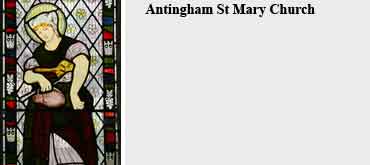 This 14th century church is believed to have been completed before the Black Death. Major restoration in the 19th century (1865) included 2 new stained glass windows by the firm of Morris, Marshall & Faulkner, designed by the renowned Pre Raphaelite artists Dante Gabriel Rossetti & Edward Burne Jones together with William Morris himself.
This 14th century church is believed to have been completed before the Black Death. Major restoration in the 19th century (1865) included 2 new stained glass windows by the firm of Morris, Marshall & Faulkner, designed by the renowned Pre Raphaelite artists Dante Gabriel Rossetti & Edward Burne Jones together with William Morris himself.
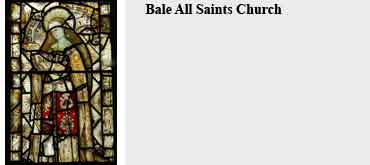 The remarkable 14th & 15th century glass, the latter attributed to the Norwich School of glass painting, is all leaded into a south window. Although the church is dedicated to All Saints, within this window alone remain two Gabriels and four Marys, leading to the assumption that the church had a particular dedication to the Annunciation.
The remarkable 14th & 15th century glass, the latter attributed to the Norwich School of glass painting, is all leaded into a south window. Although the church is dedicated to All Saints, within this window alone remain two Gabriels and four Marys, leading to the assumption that the church had a particular dedication to the Annunciation.
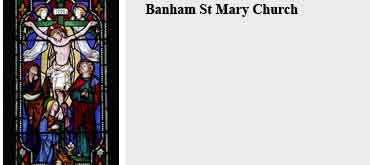 The windows themselves are predominantly of the Decorated period, with the inevitable Victorian additions. This is particularly true of the somewhat “exuberant” east window and much of the glass. Five of the windows have been designed by J Powell & Sons.
The windows themselves are predominantly of the Decorated period, with the inevitable Victorian additions. This is particularly true of the somewhat “exuberant” east window and much of the glass. Five of the windows have been designed by J Powell & Sons.
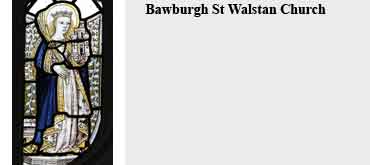 This lovely church still contains many reminders of its medieval past, when it was a centre for pilgrims worshipping at St Walstan’s shrine. Although only remnants of stained glass can still be seen, it includes samples of both 14th and 15th century work produced by the Norwich School.
This lovely church still contains many reminders of its medieval past, when it was a centre for pilgrims worshipping at St Walstan’s shrine. Although only remnants of stained glass can still be seen, it includes samples of both 14th and 15th century work produced by the Norwich School.
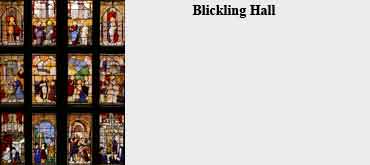 Built in the 17th century Blickling Hall is one of the England’s finest Jacobean Houses. It contains beautiful and important artefacts which include: one of the finest collections of rare books in England and an extensive collection of furniture and paintings. Stained glass can be found in both the Long Gallery and the Great Hall.
Built in the 17th century Blickling Hall is one of the England’s finest Jacobean Houses. It contains beautiful and important artefacts which include: one of the finest collections of rare books in England and an extensive collection of furniture and paintings. Stained glass can be found in both the Long Gallery and the Great Hall.
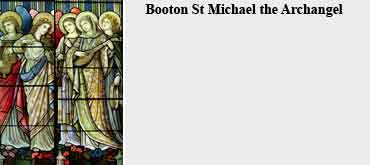 All the windows contain whimsical Victorian glass. In deference to the church’s dedication, all depict representations of angels,many of which are said to have been portraits of “blessed girls” with whom Elwin was an “affectionate, almost intimate counsellor” – as you can see they are beautiful individually and en masse create a stunning group.
All the windows contain whimsical Victorian glass. In deference to the church’s dedication, all depict representations of angels,many of which are said to have been portraits of “blessed girls” with whom Elwin was an “affectionate, almost intimate counsellor” – as you can see they are beautiful individually and en masse create a stunning group.
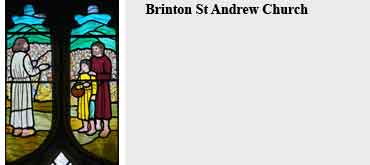 Although the church dates from the 14th century. Substantial alterations have taken place since this time including a full 19th century restoration by Frederick Preedy. The latter work resulted in the installation of stained glass including works by Mayer (a member of the renowned Munich School ) and Arthur Lewis Moore
Although the church dates from the 14th century. Substantial alterations have taken place since this time including a full 19th century restoration by Frederick Preedy. The latter work resulted in the installation of stained glass including works by Mayer (a member of the renowned Munich School ) and Arthur Lewis Moore
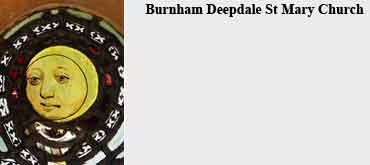 One of the major treasures in this church is its stained glass collection which includes beautiful pieces from both the Medieval & Victorian eras. For many the collection includes many children’s favourite piece :”The Man in the Moon”
One of the major treasures in this church is its stained glass collection which includes beautiful pieces from both the Medieval & Victorian eras. For many the collection includes many children’s favourite piece :”The Man in the Moon”
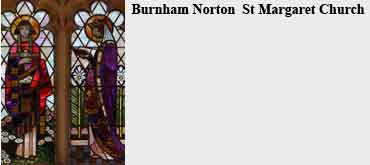 The church contains many attractive features including : its arch braced roof, the rood screen and most importantly its heptagonal wineglass pulpit with six painted panels. The East window contains stained glass comprising two beautiful art deco figures depicting St Margaret of Antioch & St Margaret of Scotland.
The church contains many attractive features including : its arch braced roof, the rood screen and most importantly its heptagonal wineglass pulpit with six painted panels. The East window contains stained glass comprising two beautiful art deco figures depicting St Margaret of Antioch & St Margaret of Scotland.
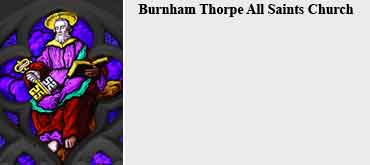 The Church rectory is renowned as the birthplace of Nelson it contains only one stained glass window which was made by S C Yarrington.
The Church rectory is renowned as the birthplace of Nelson it contains only one stained glass window which was made by S C Yarrington.
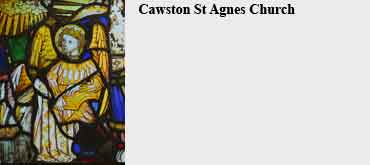 Although the church does not contain an extensive collection of glass, three panels containing all remaining medieval glass are displayed in a single window in the South Aisle. Here one can view exquisite feathered angels playing instruments, fine examples of work produced by the 15th century Norfolk School.
Although the church does not contain an extensive collection of glass, three panels containing all remaining medieval glass are displayed in a single window in the South Aisle. Here one can view exquisite feathered angels playing instruments, fine examples of work produced by the 15th century Norfolk School.
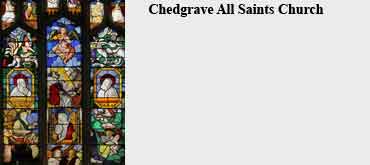 The church incorporates a magnificent Norman doorway and tower plus a Georgian north aisle. Although it has few windows the 16th/ 17th century continental glass contained in the east window is particularly attractive and is believed to have originally been made for Rouen Cathedral.
The church incorporates a magnificent Norman doorway and tower plus a Georgian north aisle. Although it has few windows the 16th/ 17th century continental glass contained in the east window is particularly attractive and is believed to have originally been made for Rouen Cathedral.
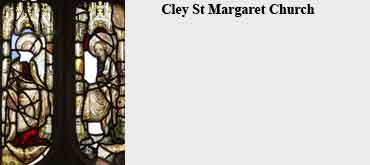 “Norfolk’s most beautiful & eccentric windows”. (Simon Jenkins) Other treasures in the church include: a seven sacrament font, a gallery of medieval carvings which adorn niches in the nave and imaginatively carved Tudor bench ends. Although not a major feature of the church it does contain fine examples of both medieval and Victorian glass
“Norfolk’s most beautiful & eccentric windows”. (Simon Jenkins) Other treasures in the church include: a seven sacrament font, a gallery of medieval carvings which adorn niches in the nave and imaginatively carved Tudor bench ends. Although not a major feature of the church it does contain fine examples of both medieval and Victorian glass
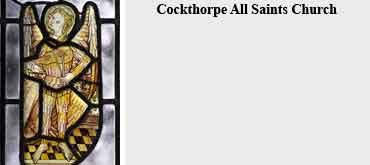 Only one stained glass window remains in the church. This portrays a delightful 15th century feathered angel playing a stringed instrument (probably a violin) with a bow
Only one stained glass window remains in the church. This portrays a delightful 15th century feathered angel playing a stringed instrument (probably a violin) with a bow
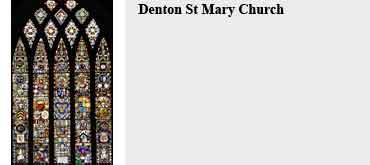 The highlight of the church is the East window with its brilliant collection of 16th / 17th fragments assembled in an eclectic mosaic. This window alone makes the church well worth a visit.
The highlight of the church is the East window with its brilliant collection of 16th / 17th fragments assembled in an eclectic mosaic. This window alone makes the church well worth a visit.
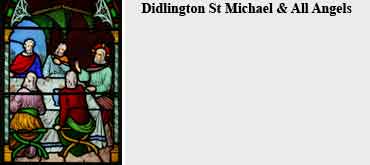 The church contains a late C13th century chancel, a Decorated tower and Perpendicular aisles & clerestory. The interior still retains medieval features including the corbel heads and arcade pillars. A small tracery light, which was previously thought to date from the 14th century, is now thought to be mid 13th century
The church contains a late C13th century chancel, a Decorated tower and Perpendicular aisles & clerestory. The interior still retains medieval features including the corbel heads and arcade pillars. A small tracery light, which was previously thought to date from the 14th century, is now thought to be mid 13th century
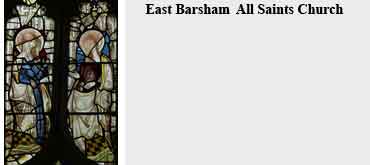 Although very little stained glass remains here two gorgeous angels in a north nave window clearly illustrate the skills of the 15th century Norwich school of glass painting.
Although very little stained glass remains here two gorgeous angels in a north nave window clearly illustrate the skills of the 15th century Norwich school of glass painting.
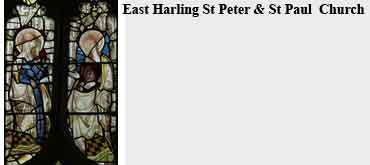 The beautiful building we see today contains many medieval treasures not least of which is its East Window described by David King as: “The most important collection of fifteenth – century glass by Norwich glass painters outside that city”
The beautiful building we see today contains many medieval treasures not least of which is its East Window described by David King as: “The most important collection of fifteenth – century glass by Norwich glass painters outside that city”
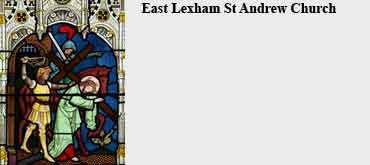 St Andrew’s round tower is almost entirely Saxon, the area below the parapet was built pre conquest possibly around 900 A.D. which would make it the oldest surviving round tower in the country. Only the Perpendicular east window contains stained glass, which was inserted during the Victorian renovation
St Andrew’s round tower is almost entirely Saxon, the area below the parapet was built pre conquest possibly around 900 A.D. which would make it the oldest surviving round tower in the country. Only the Perpendicular east window contains stained glass, which was inserted during the Victorian renovation
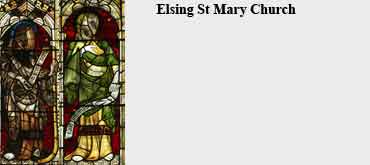 Little stained glass remains in the church, however, examples of work by both 14th and 15th century craftsman remain giving some impression of now the church glazing originally appeared.
Little stained glass remains in the church, however, examples of work by both 14th and 15th century craftsman remain giving some impression of now the church glazing originally appeared.
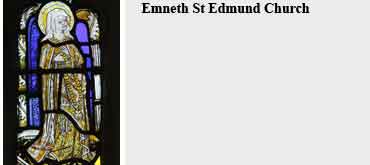 This large Fenland church is predominantly Perpendicular in design.Although it underwent an extensive Victorian renovation it still retains features from earlier periods The church has retained some small panels of medieval glass in the north aisle tracery lights however, the glass is mainly Victorian
This large Fenland church is predominantly Perpendicular in design.Although it underwent an extensive Victorian renovation it still retains features from earlier periods The church has retained some small panels of medieval glass in the north aisle tracery lights however, the glass is mainly Victorian
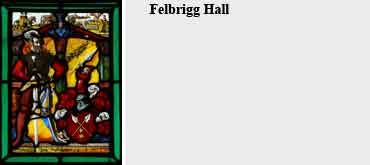 The Hall contains a fascinating collection of glass displaying a huge range of characteristics including medieval panels originally made for St Peter Mancroft and medieval European roundels.
The Hall contains a fascinating collection of glass displaying a huge range of characteristics including medieval panels originally made for St Peter Mancroft and medieval European roundels.
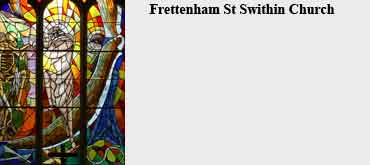 Although the church contains glass made through the ages including a 14th century depiction of the Angel Gabriel the church is dominated by the magnificent 20th century east window.
Although the church contains glass made through the ages including a 14th century depiction of the Angel Gabriel the church is dominated by the magnificent 20th century east window.
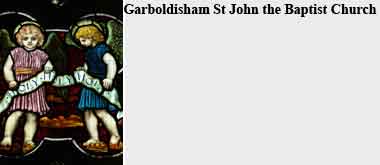 All the glass was produced by the J Powell & Sons’ workshop which enabled a series of windows to be designed which contribute considerably to the ambience of the church. The windows produced by J W Brown are exquisite and are described by Birkin Haward as being “works of national consequence”
All the glass was produced by the J Powell & Sons’ workshop which enabled a series of windows to be designed which contribute considerably to the ambience of the church. The windows produced by J W Brown are exquisite and are described by Birkin Haward as being “works of national consequence”
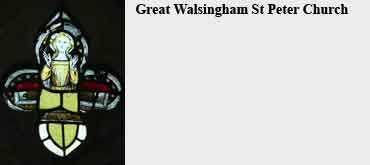 The windows are noted more for their delicate, lace like tracery (reticulated) than their stained glass, nevertheless fragments of 14th century glass can still be viewed in the tracery lights and in the heads of a selection of the main lights.
The windows are noted more for their delicate, lace like tracery (reticulated) than their stained glass, nevertheless fragments of 14th century glass can still be viewed in the tracery lights and in the heads of a selection of the main lights.
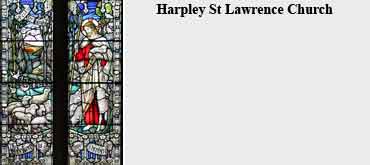 Stained glass from both the 14th and 15th century can be viewed in the windows, along with more modern examples. If you visit the church don’t forget your binoculars to enable you to appreciate the detailed pictures of 15th century saints contained in the west window.
Stained glass from both the 14th and 15th century can be viewed in the windows, along with more modern examples. If you visit the church don’t forget your binoculars to enable you to appreciate the detailed pictures of 15th century saints contained in the west window.
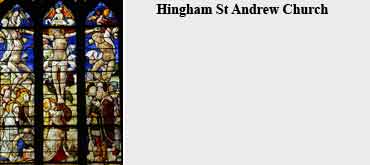 Although the windows are filled with stained glass the majority of it is unremarkable dating from the Victorian era . The East Window is, however, a notable exception and is described by David King as containing “the most impressive display of imported foreign glass in a county rich in this field.”
Although the windows are filled with stained glass the majority of it is unremarkable dating from the Victorian era . The East Window is, however, a notable exception and is described by David King as containing “the most impressive display of imported foreign glass in a county rich in this field.”
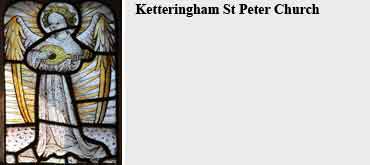 This lovely medieval church contains many riches including the East window, which contains 15th century glass of both interest and beauty.
This lovely medieval church contains many riches including the East window, which contains 15th century glass of both interest and beauty.
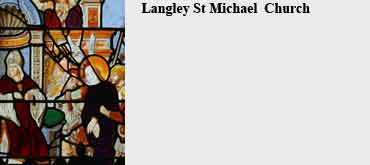 One of the most outstanding features of the church is its collection of continental glass. Much of this originated in Rouen in the 16th/17th century and following its importation by JC Hampp was brought here by the Dowager Lady Beauchamp.
One of the most outstanding features of the church is its collection of continental glass. Much of this originated in Rouen in the 16th/17th century and following its importation by JC Hampp was brought here by the Dowager Lady Beauchamp.
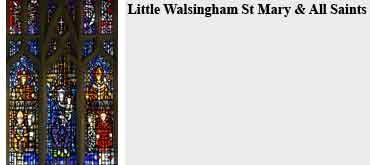 Following a devastating fire in 1961 most of the windows had to be replaced and the opportunity was taken, to install a modern east window which was both designed and executed by the renowned John Hayward. The window adds much to the ambience of the church which retains a lovely mix of colour and light.
Following a devastating fire in 1961 most of the windows had to be replaced and the opportunity was taken, to install a modern east window which was both designed and executed by the renowned John Hayward. The window adds much to the ambience of the church which retains a lovely mix of colour and light.
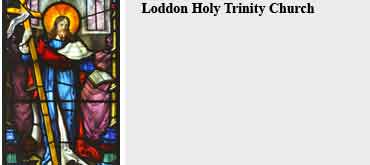 The Church was built around 1490. It is largely Perpendicular in style and contains a number of notable features including : a hammerbeam roof, a Jacobean pulpit, and a painted rood screen. Only three windows contain stained glass of these the east window with its vast array of shields is the most notable.
The Church was built around 1490. It is largely Perpendicular in style and contains a number of notable features including : a hammerbeam roof, a Jacobean pulpit, and a painted rood screen. Only three windows contain stained glass of these the east window with its vast array of shields is the most notable.
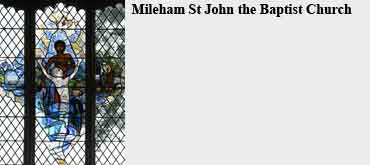 The west window “gives the best impression we can have in Norfolk of what a typical complete 14th century window would have looked like” (David King). The modern east window inserted in 2004 creates an interesting juxtaposition between the two styles.
The west window “gives the best impression we can have in Norfolk of what a typical complete 14th century window would have looked like” (David King). The modern east window inserted in 2004 creates an interesting juxtaposition between the two styles.
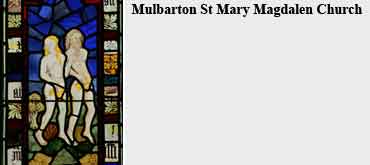 Mulbarton contains superb medieval windows. In particular the East window contains delightful 15th century figures of Adam & Eve. Additionally the south chancel contains an assortment of old glass including panels dating from c1530 which were originally made for the Abbey of Steinfeld in the Eifel region of Germany.
Mulbarton contains superb medieval windows. In particular the East window contains delightful 15th century figures of Adam & Eve. Additionally the south chancel contains an assortment of old glass including panels dating from c1530 which were originally made for the Abbey of Steinfeld in the Eifel region of Germany.
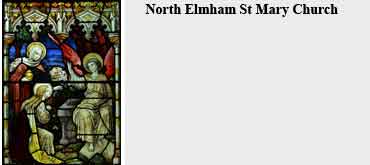 Remnants of 14th century glass can still be viewed in the church much of it displaying the green, red & yellow colour palette typically associated with the period. This is supplemented by Victorian work.
Remnants of 14th century glass can still be viewed in the church much of it displaying the green, red & yellow colour palette typically associated with the period. This is supplemented by Victorian work.
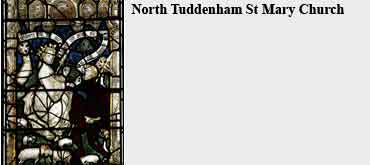 This attractive medieval church contains a superb collection of medieval stained glass which includes some of the best medieval glass in Norfolk. The 15th century scenes depicting St Margaret & St George and the figure of St Laurence are of particular note.
This attractive medieval church contains a superb collection of medieval stained glass which includes some of the best medieval glass in Norfolk. The 15th century scenes depicting St Margaret & St George and the figure of St Laurence are of particular note.
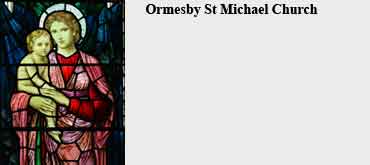 For lovers of Pre Raphaelite art, the highlight of a visit are three superb windows designed by Henry Holiday. They are so good that the east window picturing the Madonna and Child was selected to feature as the Post Office’s 2009 1st Class Christmas stamp
For lovers of Pre Raphaelite art, the highlight of a visit are three superb windows designed by Henry Holiday. They are so good that the east window picturing the Madonna and Child was selected to feature as the Post Office’s 2009 1st Class Christmas stamp
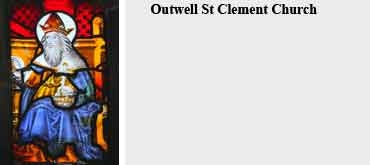 Medieval glass dating from both the 15th and 16th centuries is located in three windows. The most impressive selection can be found in the South Aisle east window (the Beaupre Chapel) where the tracery contains a selection of 16th century figures and shields.
Medieval glass dating from both the 15th and 16th centuries is located in three windows. The most impressive selection can be found in the South Aisle east window (the Beaupre Chapel) where the tracery contains a selection of 16th century figures and shields.
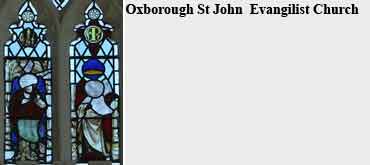 Although not a major feature of the church it retains some 14th & 15th century glass. Of particular note are the 14th century prophets located in the South chancel.
Although not a major feature of the church it retains some 14th & 15th century glass. Of particular note are the 14th century prophets located in the South chancel.
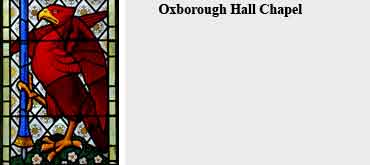 The windows contain an intriguing mix of continental and English glass, much of it dating from the middle ages. Amongst the collection is an early 13th century panel (apse window 1) believed to be the earliest stained glass in the county. Much of the glass was reset in the 20th century by G King & Sons.
The windows contain an intriguing mix of continental and English glass, much of it dating from the middle ages. Amongst the collection is an early 13th century panel (apse window 1) believed to be the earliest stained glass in the county. Much of the glass was reset in the 20th century by G King & Sons.
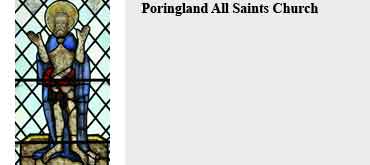 There has been a church on this site since the 12th century – although all that remains of the original building is the round tower, which was adorned with an octagonal top in the 15th century. One of the church’s greatest treasures is the medieval glass which is displayed in the east window.
There has been a church on this site since the 12th century – although all that remains of the original building is the round tower, which was adorned with an octagonal top in the 15th century. One of the church’s greatest treasures is the medieval glass which is displayed in the east window.
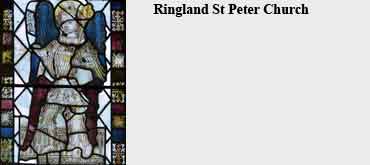 The church contains a small but outstanding collection medieval stained glass, particularly remarkable as it is rare to find so many full scale figures of this era in a Norfolk Church.
The church contains a small but outstanding collection medieval stained glass, particularly remarkable as it is rare to find so many full scale figures of this era in a Norfolk Church.
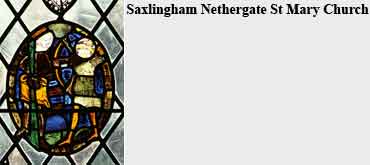 This church contains a superb collection of medieval stained glass including examplesof English glass from the 13th century.
This church contains a superb collection of medieval stained glass including examplesof English glass from the 13th century.
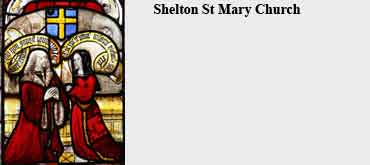 . The church contains fine examples of early 16th century glass. It is mainly secular and includes many small donor figures. There are also many shields, representing the Shelton family connection and a repeated use of the Shelton rebus i.e a shell on a tun, or barrel
. The church contains fine examples of early 16th century glass. It is mainly secular and includes many small donor figures. There are also many shields, representing the Shelton family connection and a repeated use of the Shelton rebus i.e a shell on a tun, or barrel
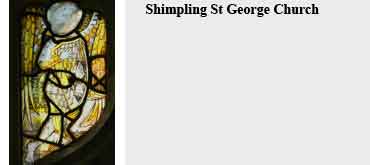 Although much of it has been destroyed, medieval stained glass can still be viewed in the church, this includes rare canopies which are believed to date from the late 13th /early 14th centuries.
Although much of it has been destroyed, medieval stained glass can still be viewed in the church, this includes rare canopies which are believed to date from the late 13th /early 14th centuries.
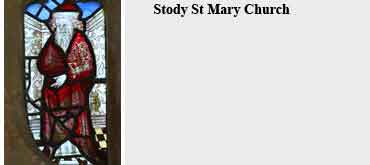 Although there is not a large collection of glass in the church it retains some 15th century glass. Of particular interest are the figures portraying the prophets, patriarchs & apostles located in two north aisle windows
Although there is not a large collection of glass in the church it retains some 15th century glass. Of particular interest are the figures portraying the prophets, patriarchs & apostles located in two north aisle windows
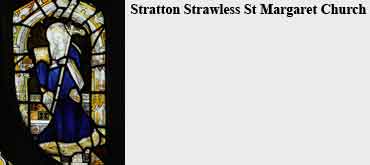 Although stained glass is not a major feature of the church it retains fine examples of 15th century English glass in two North aisle windows
Although stained glass is not a major feature of the church it retains fine examples of 15th century English glass in two North aisle windows
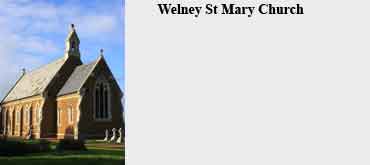 Dating from c1848 the East window contains a beautiful and unususl enamel painting of Charity.
Dating from c1848 the East window contains a beautiful and unususl enamel painting of Charity.
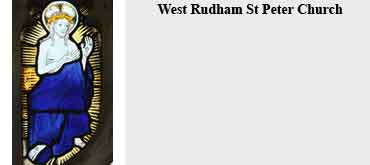 Stained galss is not a major feature of the church. It does however retain some medieval glass including a rare panel dating from the mid 15th century picturing “Christ of Pity”
Stained galss is not a major feature of the church. It does however retain some medieval glass including a rare panel dating from the mid 15th century picturing “Christ of Pity”
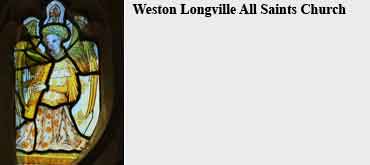 Stained glass remains in the tracery lights of three south aisle windows. Although some of the figures originate from the 15th century, and include those typical of the Norwich school, much of the glass was restored by John Dixon in the 19th century which involved replacing large portions of figures – sometimes in their entirety.
Stained glass remains in the tracery lights of three south aisle windows. Although some of the figures originate from the 15th century, and include those typical of the Norwich school, much of the glass was restored by John Dixon in the 19th century which involved replacing large portions of figures – sometimes in their entirety.
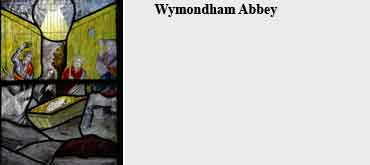 Stained glass is not a major feature of the Abbey and can only be seen in two windows. One includes glass designed by Joseph Grant of Costessey whilst the other contains 15th century remnants.
Stained glass is not a major feature of the Abbey and can only be seen in two windows. One includes glass designed by Joseph Grant of Costessey whilst the other contains 15th century remnants.